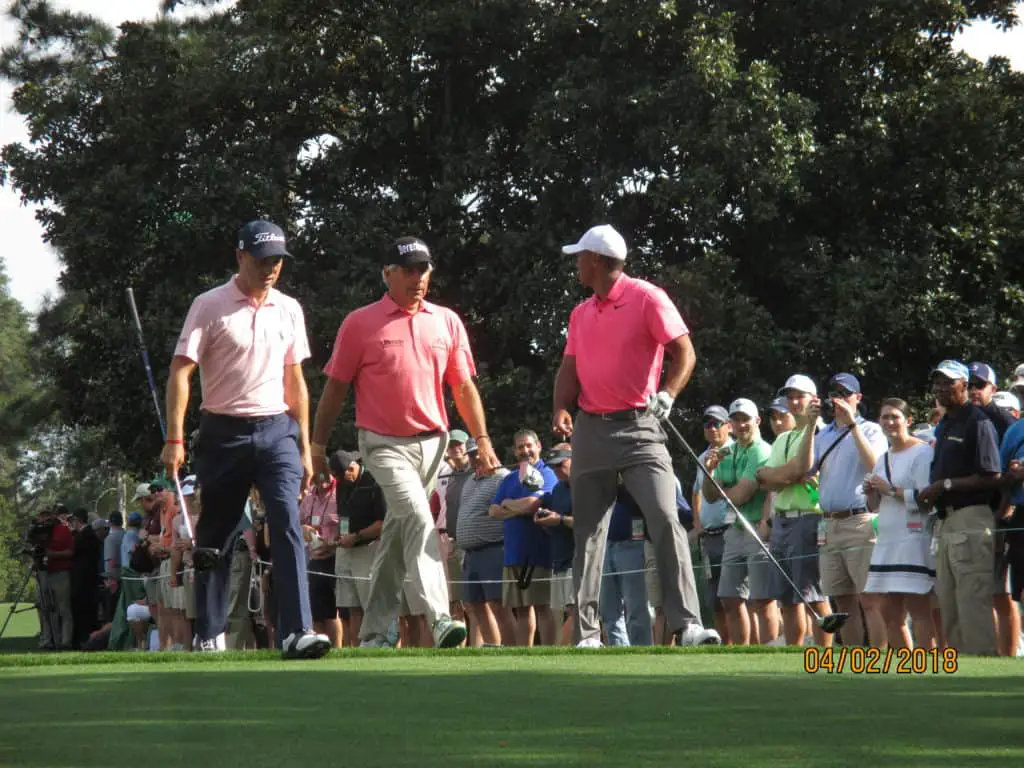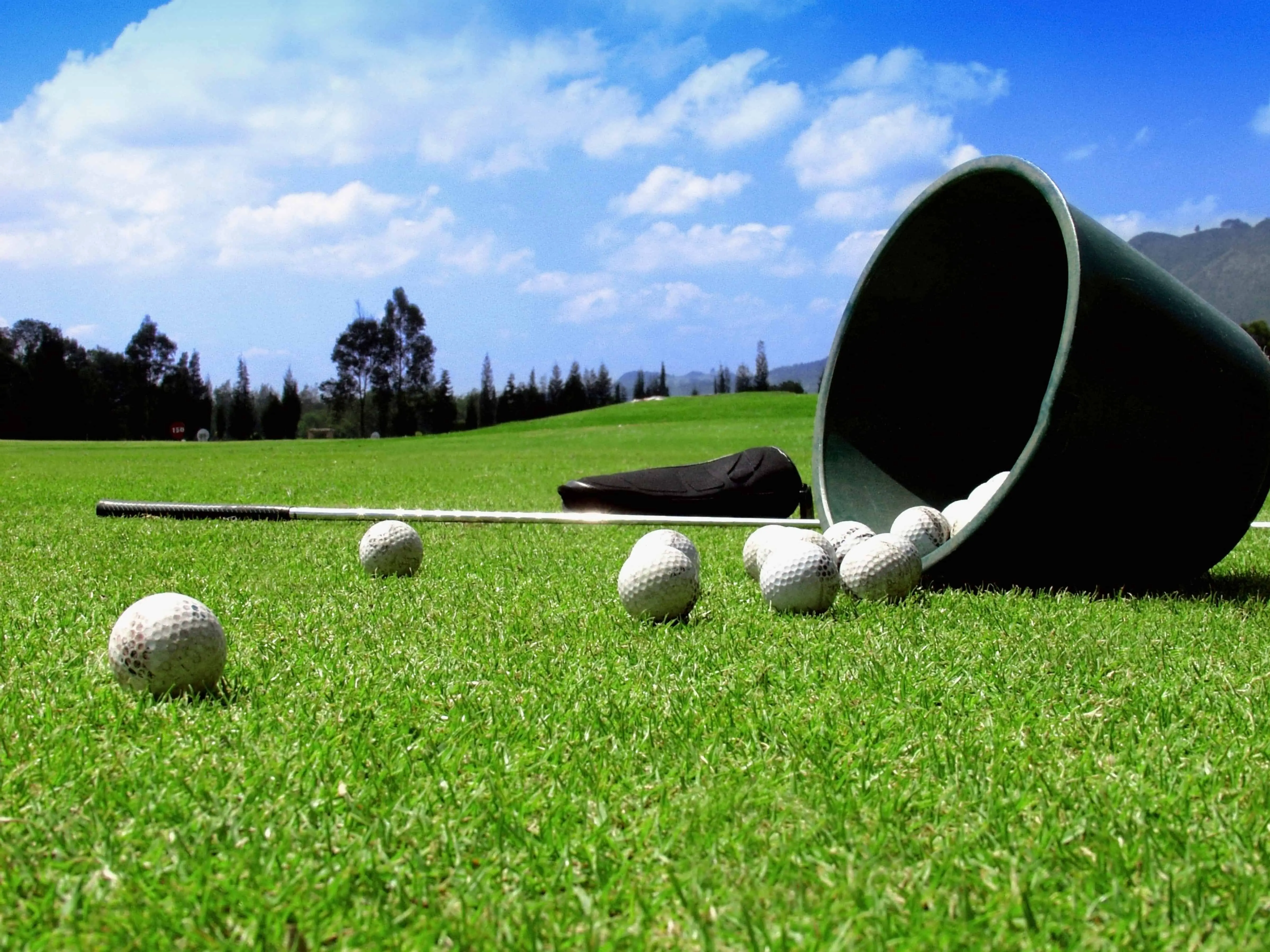The ball position for a 7 iron should be somewhere as far forward as off of your front pectoral muscle and as far back as just past the middle of the stance. The golfer should experiment with the different options to see which produces the most consistent shot relative to the target line and the curve they desire.
When it comes to ball positions, there are two different camps.
There is the camp that believes the ball position should stay relatively standard regardless of the club that the golfer is using.
They will point to a player like Jack Nicklaus who played the ball off of his left pectoral muscle regardless of the club.
The other camp believes that the ball position should move depending on the club being used and the shot being hit (high, low, draw, fade, etc).
They will point to a player like Tiger Woods who moved the ball slightly back and forth.
So what is the best option? We will explore the pros and cons of both approaches.
Ultimately, we want to help you decide on a ball position for your 7 iron and all of your clubs.
Ball Position For 7 Iron?
Update: I currently play my 7 iron more towards the front of my stance. There was a period of time when it was middle of the stance to back. However, the more I have shallowed my angle of attack, the more it has moved forward. I am able to hit a consistent ball flight in this position and hit it clean a high percentage of the time! Find the position best for your game!
All golfers seek consistency, I believe that there are three keys to consistency. These include:
- Striking the ball solid 100% of the time.
- Starting the ball on the intended start line at least 70% of the time.
- Controlling the curve of the ball at least 70% of the time.
Ultimately, the golfer wants to hit a solid shot that starts either just right or left of the target line and curves slightly towards the target. This is a stock shot a golfer can rely on to create consistency.
When determining the best ball position for your 7 iron and every other club, you will want to use these three measurements above.
Below I will discuss the pros and cons of the set ball position or one that moves from club to club and shot to shot.

Pros of a ball position always off the front pectoral muscle:
- The golfer does not have to adjust from club to club.
- The golfer can help control the low point.
- The golfer can maximize the launch angles to maximize distance.
Pro #1: The golfer does not have to adjust from club to club
The golfer grabs his or her club, goes through the routine and sets up the same with every club. There is little thought or concern and the golfer is able to feel the comfort of seeing the ball in the same position with every shot in the bag. Over time, this consistency can lead to comfort and help control pro number 2.
Pro #2: The golfer can help control the low point
One of the basics of the game is being able to control the low point. With the ball in the same position with every club, the golfer can once again have comfort and consistency in having a similar low point on every swing. This can lead to quality ball striking and little adjustments to truly become a quality ball striker.
Pro #3: The golfer can maximize the launch angles to maximize distance.
The ball position that is played more forward in the stance can help the golfer that might struggle to launch the ball high enough and far enough. The ball more forward helps the golfer launch the ball higher. For the highest handicap amateurs playing the ball more forwards to learn to hit the ball slightly on the upswing can be a positive.

Pros of a ball position that moves:
- The golfer can create more shot patterns.
- When playing in the wind, the golfer is able to move the ball back to keep the ball low.
- Enables the golfer to become an artist and play the shot required.
Pro #1: The golfer can create more shot patterns.
In my game, I prefer to move the ball around. This allows me to hit different shaped shots throughout the round. Overall, if I want to hit a low draw, the ball might be just back of the center of my stance. This allows me to strike the ball on the back side of the swing arch, producing a swing path that is in to out and allows me to hit a draw.
If I want to hit a higher fade, I will play the ball more forward in my stance, which allows me to catch it more on the front of the swing arch, producing more of a left to right shot pattern.
Pro #2: When playing in the wind, the golfer is able to move the ball back to keep the ball low.
The wind is a major factor in many locations when playing golf, especially when playing a seaside course. The ability to keep the ball low and less impacted by the wind is vital. Playing the ball back in the stance, makes this easier.
Pro #3: Enables the golfer to become an artist and play the shot required
There is often the debate over whether golf is more science or more art. I prefer to play the game with more feel, especially when different shots are required or are the optimum shot. Feeling the shot and being able to work the ball is easier when the ball positions moves around in the swing.
Next Steps: Ball Position for 7 Iron
I would highly recommend experimenting with the two options described above. Find out what is best for you. There are some things you will want to measure:
- Consistency in your start line
- Consistency in ball contact
- Consistency in the curve of the ball
During your practice sessions pick a specific target, hit the shot and record some key information:
- Did the ball fly the intended distance?
- DId the ball curve the way you expected?
- Did the ball start down your intended line?
Hit 20-30 shots with both of the two options above. Which one provided the best results?
Next head out to the course and play with one of the methods and see how it transfers to the golf course. Being able to hit solid shots on the range is one thing, but doing it on the course is another. See if your approach can carry over to the golf course.
If you happen to own a launch monitor like a Skytrak, recording this data and looking at these key factors can be really helpful:
- Ball speed
- Spin Rate
- Spin Axis
- Launch Angles
These portable launch monitors are rather impressive and are much less money than the Trackman and other expensive devices that the professionals use, but provide some key information at a lot less money. Here are three incredible options:
If you head to any PGA Tour event, you will see golfers working with their launch monitor. Now, for a fraction of the price, the amateur golfer can have some amazing data that can be a game changer. The feedback after every shot is impressive.
It allows the golfer to experiment with different things like ball position, swing paths, best options for clubs and other key decisions that golfers must make in their game.
Final Thoughts: Ball Position for 7 Iron
Ball position is not a fundamental in the game of golf because there are various ways to play a variety of shots. Not every professional on tour is going to play a 7 iron from the same ball position as the next player. The key is to find what works for your game and your swing.
Measure and assess the quality of the shots that you hit with various ball positions. The best golfers hit thousands of golf balls during practice to build their swing, comfort level and to have a solid understanding of how the ball will react when they change a variety of variables within their swing.
Take Action – What You Can Do Today to Get Better
What does this mean for you? I believe in the following recipe to get better:
1 – Improve your motion in the golf swing by identifying a golf instructor. Here are some options:
Here is a list of golf instructors that we have reviewed:
2 – Train to swing faster and improve your swing speed. Here are some options:
Looking to gain more Speed and Distance in your swing. Two Options:
3 – Understand course strategy and work to break through your next barrier. Here is a series on breaking through:
We have provided guides on how to break 100, 90, 80 and 70. Check out more below, if interested.
4 – Practice Frequently
Did you know that I build a golf simulator in my garage and have played over 500 rounds of golf on my SkyTrak system? It has been a game changer and one worth checking out. Here are some of my other posts on golf simulators frequently asked questions:
- Is a Golf Simulator Worth It?
- How to Build a Golf Simulator?
- What is the Best Golf Simulator?
- Golf Simulator Accessories?
- How to Build a Golf Simulator for under $7000
- Top 11 Reasons to Buy a SkyTrak
- How to Build a Golf Simulator for Under $1000
- Why Build A Golf Simulator?
- What Space is Needed?
- Can A Golf Simulator Improve My Game?
- How Much Does A Golf Simulator Cost?
- Don’t Forget to Check out our 15 best golf swings of all time.

